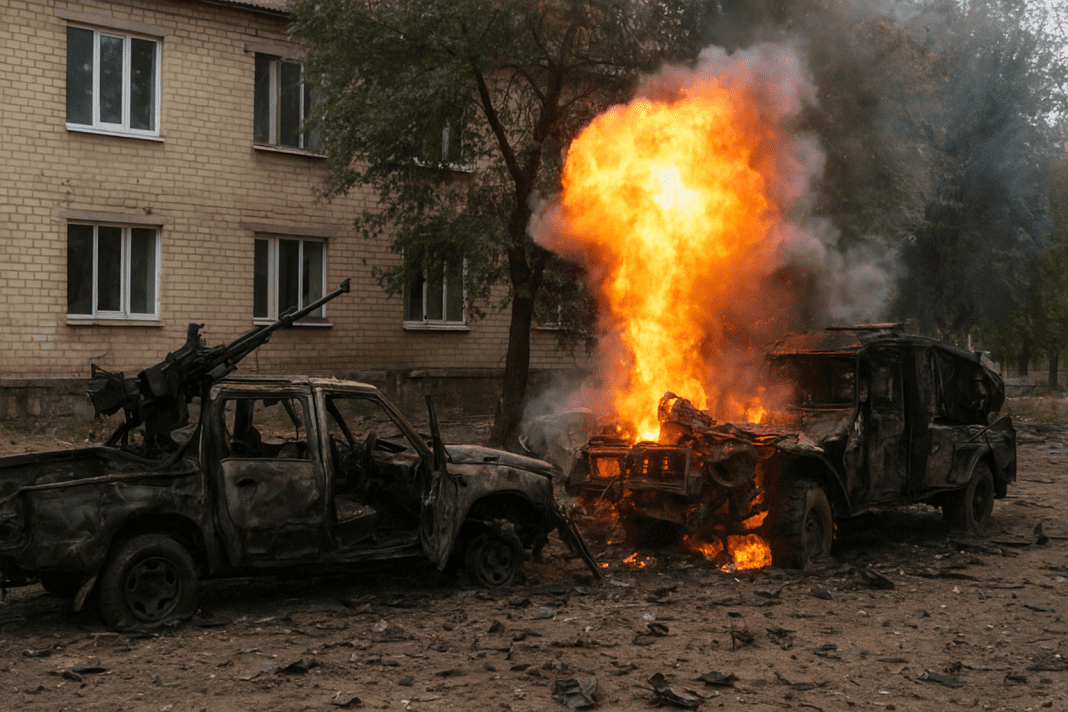Ukrainian intelligence confirmed the destruction of a Russian mobile air defense unit in the occupied settlement of Kalynove, located in the Luhansk region, on August 22.
Ukrainian intelligence strikes in occupied Luhansk settlement
The incident involved a powerful explosion that took place in the courtyard of a residential building. At the time of the strike, six Russian servicemen and their military vehicles were present at the site.
According to Ukrainian intelligence, the Russian group had been deployed as a mobile air defense team. Their task was to provide protection for a nearby military repair base operated by Russian forces. This setup made the unit a critical component in safeguarding military assets in the occupied region.
Deadly precision: Ukrainian drone-laser combo kills 5 Russian sailors in Kherson Oblast
The sudden detonation resulted in heavy destruction. Reports indicate that two pickup trucks fitted with machine guns were wiped out, along with a UAZ vehicle that was carrying ammunition. The loss of these vehicles weakened the operational strength of the deployed unit. The courtyard itself, where the vehicles and personnel were gathered, became the center of the blast, leading to immediate casualties.
Ukrainian intelligence confirms Russian troop losses
Ukrainian intelligence reported that three Russian servicemen were killed as a result of the explosion. Two more sustained severe injuries during the strike and required urgent medical attention. The location, which had been temporarily used as a defensive staging ground, became a scene of devastation within moments.
The destroyed vehicles carried weapons and ammunition that added to the intensity of the explosion. With ammunition igniting on impact, the courtyard turned into a hazardous zone, reducing the chances of survival for those present. Ukrainian intelligence stressed that the strike was aimed at disabling Russian military capabilities and targeting groups that played an active role in ongoing hostilities.
Details provided by Ukrainian intelligence revealed that the destroyed unit had not only been stationed in Luhansk but also had a history of deployment in earlier stages of the war. Reports confirmed that this same group had previously taken part in military operations in the Bucha area of Kyiv region in 2022. That period is remembered for widespread atrocities, which drew international attention to the conduct of Russian forces during the invasion.
By confirming the link between the destroyed unit and the events in Bucha, Ukrainian intelligence underlined the significance of the strike beyond its immediate military value.
Previous Operations and Larger Impact
The Kalynove strike was not the first major blow delivered by Ukrainian intelligence during the month. Earlier, on August 5, Ukrainian intelligence carried out a large-scale special operation near Sumy. That operation, involving the “Timur” unit and supporting formations, resulted in heavy losses for Russian forces. Reports stated that more than 330 Russian troops were killed, while over 550 were wounded. The outcome disrupted Russian logistics and halted their advance in that sector.
The Kalynove operation, though smaller in scale, carried notable symbolic weight. By eliminating a unit directly connected to earlier war crimes, Ukrainian intelligence reinforced its message of accountability. The destroyed vehicles, the confirmed troop casualties, and the link to Bucha highlighted the precision and intent behind the operation.
Powerful Ukrainian strike hits Borisoglebsk air base, base of Russia’s Su-34 and Su-35S jets
Each operation carried out by Ukrainian intelligence in occupied territories added to the cumulative pressure on Russian forces. Strikes not only damaged equipment and personnel but also undermined Russian efforts to secure logistical and operational control in contested areas. The destruction of the Kalynove air defense unit was an example of how localized operations could carry strategic and moral importance.
The focus on eliminating specialized units, such as mobile air defense groups, also impacted the broader battlefield. Without such units, Russian forces faced greater difficulty in protecting their assets from Ukrainian air and drone attacks. The incident further demonstrated how Ukrainian intelligence-led operations played a role in shaping battlefield dynamics.

